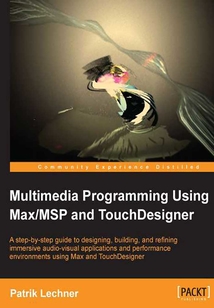首頁 > 計算機(jī)網(wǎng)絡(luò) >
硬件與維護(hù)
> Multimedia Programming Using Max-MSP and TouchDesigner最新章節(jié)目錄
舉報 

會員
Multimedia Programming Using Max-MSP and TouchDesigner
最新章節(jié):
Index
IfyouwanttolearnhowtouseMax6and/orTouchDesigner,orworkinaudio-visualreal-timeprocessing,thisisthebookforyou.Itisintendedforintermediateusersofbothprogramsandcanbehelpfulforartists,designers,musicians,VJs,andresearchers.Abasicunderstandingofaudioprinciplesisadvantageous.
目錄(100章)
倒序
- 封面
- 版權(quán)頁
- Credits
- About the Author
- About the Reviewers
- www.PacktPub.com
- Support files eBooks discount offers and more
- Preface
- What this book covers
- What you need for this book
- Who this book is for
- Conventions
- Reader feedback
- Customer support
- Chapter 1. Getting Started with Max
- Understanding the basic concepts of Max
- Modular basis for expressions
- When to use Max
- Summary
- Exercises
- Chapter 2. Max Setup and Basics
- Setting things up
- Basic Max patching and GUI
- Creating our Hello World program
- A quick overview of GUI
- Summary
- Chapter 3. Advanced Programming Techniques in Max
- Introducing the synthesizer example
- Initializing a patcher
- Excursus of microscopic timing and message ordering
- A bpatcher for MIDI input
- Sending and receiving data
- The #n notation
- Collections of data
- More message box magic
- Structuring our patches
- Timing in Max
- The event priority
- Debugging
- Scripting and the this patcher
- Summary
- Chapter 4. Basic Audio in Max/MSP
- Basic audio principles
- Audio synthesis
- Sampling and audio file playback
- Mixing and signal routing
- Summary
- Chapter 5. Advanced Audio in Max/MSP
- More sampling
- FX
- FFT
- Sample-accurate sequencing
- Summary
- Chapter 6. Low-level Patching in Gen
- Introducing Gen
- The Gen workspace
- Examples
- Further reading
- Summary
- Chapter 7. Video in Max/Jitter
- Inputting and outputting Jitter data
- Getting started with the Jitter matrix
- Using OpenGL in Jitter
- Summary
- Chapter 8. Max for Live
- Introducing the fundamentals of Max for Live
- Parameters and saving
- The Live API
- An example device – a parameter modulator
- Summary
- Chapter 9. Basic Visualization Using TouchDesigner
- The need for TouchDesigner
- How to get help
- Basics and UI of TouchDesigner
- Summary
- Chapter 10. Advanced Visualization Using TouchDesigner
- The basic audio-reactive video
- A 2D composting example
- Replicator COMP
- Connecting Max and TD
- A component for lots of movies
- Converting between OP families
- Dealing with time
- Introducing 3D rendering
- Summary
- Chapter 11. 3D Rendering and Examples
- Interactive and non-procedural tools
- The Geo COMP
- Camera light and shading
- Summary
- Chapter 12. Connecting Our Software to the World
- Analog synths and control voltage
- Arduino and microcontrollers
- Multi-touch screens
- Interfacing other programs
- Multispeaker setups
- Exporting an application
- Collaborative work
- Summary
- Index 更新時間:2021-08-05 17:21:45
推薦閱讀
- 觸摸屏實(shí)用技術(shù)與工程應(yīng)用
- Cortex-M3 + μC/OS-II嵌入式系統(tǒng)開發(fā)入門與應(yīng)用
- 數(shù)字道路技術(shù)架構(gòu)與建設(shè)指南
- 硬件產(chǎn)品經(jīng)理成長手記(全彩)
- 電腦組裝、維護(hù)、維修全能一本通(全彩版)
- 計算機(jī)應(yīng)用與維護(hù)基礎(chǔ)教程
- 3ds Max Speed Modeling for 3D Artists
- Unity 5.x Game Development Blueprints
- 單片機(jī)原理及應(yīng)用系統(tǒng)設(shè)計
- 分布式微服務(wù)架構(gòu):原理與實(shí)戰(zhàn)
- Machine Learning with Go Quick Start Guide
- 固態(tài)存儲:原理、架構(gòu)與數(shù)據(jù)安全
- Neural Network Programming with Java(Second Edition)
- 新編電腦組裝與硬件維修從入門到精通
- 3D Printing Blueprints
- Intel FPGA權(quán)威設(shè)計指南:基于Quartus Prime Pro 19集成開發(fā)環(huán)境
- Angular 6 by Example
- 分布式存儲系統(tǒng):核心技術(shù)、系統(tǒng)實(shí)現(xiàn)與Go項目實(shí)戰(zhàn)
- 主板維修實(shí)踐技術(shù)
- ActionScript Graphing Cookbook
- 嵌入式系統(tǒng)原理:基于Arm Cortex-M微控制器體系
- Mastering JavaServer Faces 2.2
- 三菱FX2N系列PLC入門與應(yīng)用實(shí)例
- Deep Learning for Beginners
- 視頻處理加速及應(yīng)用實(shí)踐:基于英特爾GPU
- CANoe開發(fā)從入門到精通
- 微型計算機(jī)接口技術(shù)
- Linux虛擬化數(shù)據(jù)中心實(shí)戰(zhàn)
- 零基礎(chǔ)輕松學(xué)修筆記本電腦
- 青雨紅顏:Photoshop古風(fēng)水彩CG插畫繪制技法

